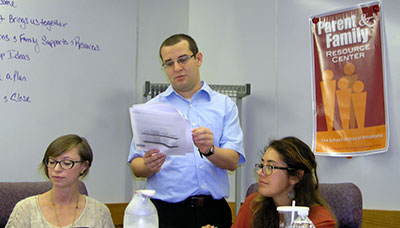Six Philadelphia Schools Open with a Dual Language Program Guided by Nelson Flores
September 8, 2014 — The important thing to remember in a bilingual education program, Nelson Flores told the teachers, is that a skill is a skill.
If a child is learning the skill, it initially doesn’t matter if they learn it in English or Spanish, Flores said. As they learn the languages, they will learn to think in the languages, and the skills will translate.
Flores, a Penn GSE assistant professor, stood before a dozen teachers and officials from the School District of Philadelphia on a late August morning. Last year, he began holding a series professional development sessions like this for city teachers.

Now Flores and the district are going further. Flores and his Penn GSE colleagues are helping the district redesign the bilingual language programs at five elementary schools. Before, four of these schools operated what are known as transitional programs. Children who predominantly spoke Spanish were taught English. As they got older and became more fluent in English, lessons in Spanish faded away.
Starting this year, all five schools will offer dual language programs. Students will be taught in both English and Spanish. Developing skills in both languages will be given equal weight. Children that grew up in predominantly English-speaking homes will be able to learn Spanish in the same manner their classmates learn English.
The change means re-thinking everything from how papers are graded to the progress children should be making in their non-dominant language. The district has relied on Flores as a sounding board for these key decisions, said Allison Still, the district’s Acting Director of Multilingual Curriculums and Programs.
At the seminars in August, Flores gave teachers different grading models they could incorporate into their work. The teachers, in turn, explained which they thought would work, which wouldn’t, and why, offering their own ideas along the way. That’s typical of the give-and-take between the theoretical and the practical that has shaped the new programs.
“Nelson’s guidance and expertise has been so valuable,” Still said. “If we didn’t have this support from Penn GSE, we wouldn’t be able to do this at the level we’re doing it.”
Flores is a member of Penn GSE’s internationally renowned Educational Linguistics Division. Researchers here are examining the role of language in learning and teaching; studying the role language plays in communications across cultures; training the next generation of English teachers; and preserving indigenous languages across the globe.
The district’s shift reflects the latest research on how children learn languages, Flores said.
For many years, teachers were trained to strictly separate two languages throughout the day to avoid confusion, Flores said. Since then, researchers found children perform better if they are allowed to move more freely between languages. As their comprehension improves in one language, it often improves in the other.
Bilingual education is not new to the city.
In the 1960s, Philadelphia had one of the best bilingual programs in the country, said Flores, who is researching the history of bilingual education in the city. At times, children learned in Spanish, Chinese, Cambodian, Vietnamese, and Russian. A variety of factors — including changes in philosophy, school budgets, an increased focus on standardized testing, and fewer specialized teachers — whittled away the programs over time, until the transitional Spanish program remained.
The district’s return to bilingual programs recognizes two demographic changes in the city, according to Still.
First, the city’s Hispanic population is changing. Many Hispanic students are second or third generation. They speak some Spanish, but have enough English fluency that they don’t need a transitional program. Because the Spanish they do know is largely conversational, many of these students need classroom work to be able to read and write in the language.
The second change, Still said, is that many parents in English-dominant or English-only households want their children to master a second language. Refocusing the programs meets both demands. That’s a priority for the district. Building a robust dual language program is a key point in the district’s action plan. Flores has been instrumental in supporting the district’s plan to make that happen.
In addition to the five elementary schools where the dual language program is being re-launched, the district is starting a sixth, at Southwark School.
The dual language program has the potential to foster better school communities, said Sonia Adams, a first grade teacher at Alexander K. McClure Elementary School.
In the past, parents who only speak Spanish have told her that once their children learn English, they often want to speak in English, Adams said. It can lead to communication breakdowns in the family.
Families are less likely to see the bilingual program as an attempt to convert their children from Spanish to English, Adams said. If anything, the program validates their parents’ language. That means these parents are more likely to engage teachers on all kinds of issues. More active parents make for more successful students.
But really, Adams said, the program will help all students.
“It’s the real world,” Adams said. “That’s how things are. The Spanish-speaking population is growing. In the future, it will be an asset to know both.”
